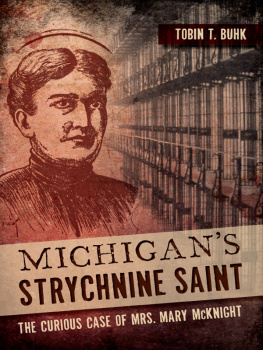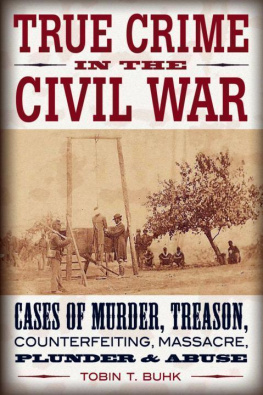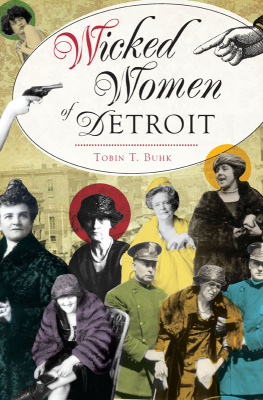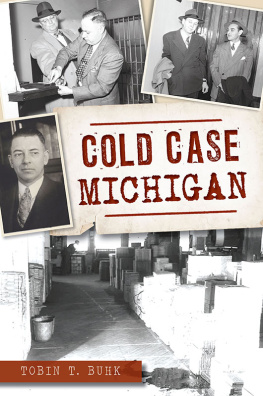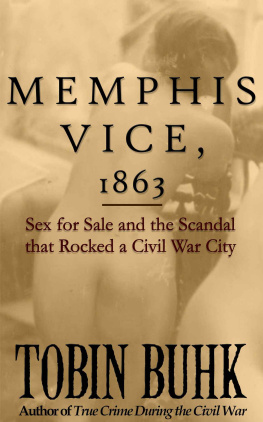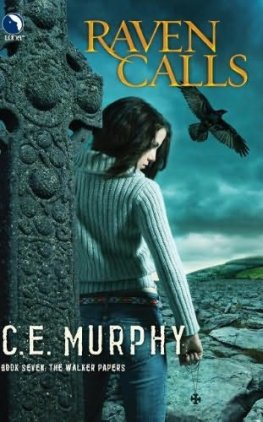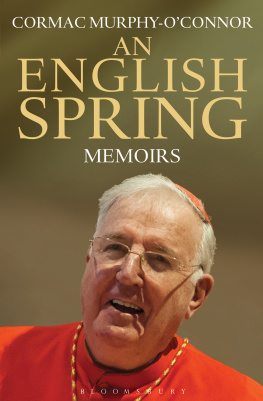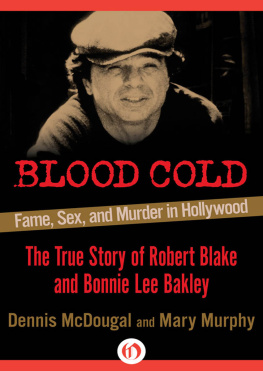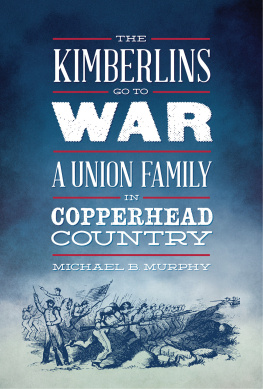

Published by The History Press
Charleston, SC 29403
www.historypress.net
Copyright 2014 by Tobin T. Buhk
All rights reserved
First published 2014
e-book edition 2014
ISBN 978.1.62584.741.6
Library of Congress CIP data applied for.
print edition ISBN 978.1.62619.257.7
Notice: The information in this book is true and complete to the best of our knowledge. It is offered without guarantee on the part of the author or The History Press. The author and The History Press disclaim all liability in connection with the use of this book.
All rights reserved. No part of this book may be reproduced or transmitted in any form whatsoever without prior written permission from the publisher except in the case of brief quotations embodied in critical articles and reviews.
Contents
Acknowledgements
Writing a book is a true labor of love but one not possible without the gracious help and support of others.
In particular, I would like to thank Jennifer Richmond for her help in tracking down old prisoner records in Detroit; Fel Brunett, historian and curator of the Fife Lake Museum, for his help in obtaining images of early twentieth-century Fife Lake; and Lisa Leach, secretary of the board of directors of the Fife Lake Historical Society, for her assistance in tracing the Murphy family tree and supplying several unique images for this text. Lisas input on Murphy family genealogy and her insight into Mary McKnights past were not only vital to this work but also inspirational. From locating a copy of the mysterious mortgage document to shooting a few photographs of Murphy family headstones (two of which appear in this volume), Lisa has provided invaluable research on the subject.
Breathing life into long-gone characters is no easy task. While every effort has been made to ensure the following text is historically accurate to a T, the occasional slip up sometimes occurs. If there are any unintended errors, they are mine and mine alone.
What you are about to read is a true story, unembellished by fictionalized dialogue or other window dressings of the novelist.
Introduction
SPRINGFIELD CEMETERY, SPRINGFIELD TOWNSHIP, MICHIGAN
Wednesday, June 3, 1903
John Jors, sexton of the Springfield Cemetery, stared at the headstone of Gertrude Murphy as the diggers began skinning the grass beside her marker. The tombstone contained just one name, but the sexton knew that the grave held two bodies: a mother and daughter who died tragically just an hour apart on April 20.
Jors ran his hand across the smooth marble and eyed the bare earth covering the adjacent grave site. Just five days earlier, they had unearthed that grave. The exhumation led to disturbing questions, and the county prosecutor hoped to find the answers in Gertrude Murphys coffin.
Within an hour, the gravediggers had removed the topsoil and created a trench about seven feet in length. They stood waist deep in the hole and tossed out shovels of dirt as they burrowed their way deeper. The earth was loose and easy to move, so it wouldnt take them much longer to reach the coffin about three feet below.
Sheriff John W. Creighton stood at the edge of the grass and peered into the trench. Creighton felt a knot in his stomach. He massaged the bridge of his nose with his thumb and forefinger, while Kalkaska County prosecutor Ernest C. Smith anxiously shifted his weight from one foot to another. Dr. Perly W. Pearsall, a local physician, thumbed through his bag for the scalpel he would use to remove the stomachs of both bodies. Smith would then take the organs to a chemist in Ann Arbor. Jors crossed his arms and watched the men work.

Map of Kalkaska County from the H.F. Walling Atlas, published in 1873. The Murphy family lived in section 21 of Springfield Township at the southwest corner of the county. Fife Lake is just across the county line, in Grand Traverse County. Authors collection.
Until a few weeks ago, none of them had witnessed an exhumation; now, they were on their second in a week.
Although Jors understood the necessity for the spadework, he felt a sense of uneasiness. Unlike the first grave they had unearthed a few days earlier, this one contained two corpses: a childRuth Murphyburied in the arms of her mother, Gertrude. Jors remembered vividly the wake and the open casket in which the mother held her precious daughter in one final, everlasting embrace.
Now, a month later, the earth would disgorge a ghastly sight. Two bodies withered by decomposition, the white silk lining of the coffin stained by the body fluids that caused their torsos to bloat and then burst. It was the natural way of death, but it was also an ugly process that people kept hidden in caskets beneath layers of earth. Yet in this case, Smith and Creighton couldnt let the dead rest in peace.
Part 1
Death Suits Her
The Wake
THE MURPHY FARM, SPRINGFIELD TOWNSHIP
Wednesday, April 22, 1903
Carriages lined the dirt road leading to a small white two-story house as relatives came to pay their last respects to Isaiah John Murphys twenty-two-year-old bride, Gertrude, and their three-month-old daughter, Ruth. The young couple had moved in with Johns sixty-six-year-old mother, Sarah, while they put the finishing touches on a new home on a nearby forty-acre parcel of land. Johns widowed sister, Mary (Murphy) McKnight, and cousin Mary Mullen also lived with Sarah Murphy.
Two days earlieron April 20Gertrude had gone to work at the new house and left Ruth in the care of Mary McKnight. Aunt Mary tucked Ruth into her crib for an afternoon nap. A few hours later, she went to check on the baby and found an appalling sight: Ruth, her skin baby-blue, lay motionless. She had apparently become entangled in the soft bed linen and suffocated.
Gertrude returned around lunchtime. When Mary broke the news about Ruth, she flew into hysterics, wildly gesturing, pacing back and forth and mumbling incoherent ramblings in between loud shrieks. Once Sarah and Mary managed to calm Gertrude, John went to Fife Lake to purchase a coffin from the undertaker Willis Brower.
While he was gone, Gertrude became suddenly ill. She complained of a neck ache and shivered as if she had the grip. Then she experienced a violent convulsion. Her body twitched spasmodically; she foamed at the mouth and threw her head back. Her lips were drawn, exposing her teeth and forming a sinister expression, like she had just seen a demon. She clenched her fists so tightly they turned white, and her balled hands snapped up toward her chest like some malignant puppeteer had yanked strings attached to her arms. The convulsion lasted for a few painful minutes, and then her body appeared to relax, her hands opening and dropping to her sides.

Fife Lake, circa 1900. Willis Browers store and mortuary is the brick building behind the bandstand. His brother, E.C. Brower, owned the store in the foreground. While John Murphy traveled to Fife Lake to purchase a coffin for his daughter, Ruth, his wife, Gertrude, mysteriously died. Fife Lake Historical Society.
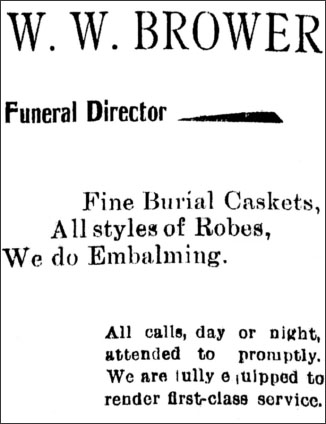
Next page
